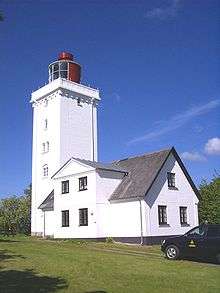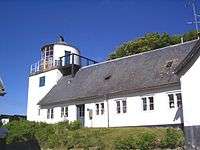Nakkehoved Lighthouse
Nakkehoved Lighthouse (Danish: Nakkehoved Fyr) was originally the name for two individual lighthouses above the Nakkehoved cliffs. Since the eastern lighthouse was decommissioned in 1898, the name Nakkehoved lighthouse has come to refer to only the western tower, which is still operational.
 Nakkehoved Lighthouse (western tower) | |

| |
| Location | Gilleleje, Denmark |
|---|---|
| Coordinates | 56°7′9.38″N 12°20′34.97″E |
| Year first constructed | 1772 |
| Year first lit | 1800 |
| Automated | 2003 |
| Tower shape | rectangular |
| Tower height | 21 meters |
| Focal height | 54 meters |
| Original lens | Fresnel lens |
| Light source | incandescent bulb |
| Intensity | 229,358 cd |
| Range | 25 nautical miles |
| Characteristic | Gr Fl (3) W 20s |
| Admiralty number | C1872 |
| NGA number | 4592 |
| ARLHS number | DEN-028 |
| Managing agent | Museum Nordsjælland |
| Heritage | monument on Kulturstyrelsen register |
The lighthouse marks the entrance to the Kattegat sea, and parallels the Kullen Lighthouse in Sweden on the other side of the Øresund strait. The tower is 21 meters tall emits 3 blinks of 0.3 second duration every 20 seconds. The light has a brightness of 229,358 cd, and can be seen from 25 nautical miles (ca. 46 km) away in clear weather.[1][2]
On the site there is also an automated weather station, restaurant, and since May 15, 2005, a Museum of International Lighthouse History.[3][4]
History
Until the end of the 18th century, only three lighthouses in Skagen, Anholt, and Kullen guided the shipping route through the Kattegat. Two towers were proposed instead of one so that sailors could differentiate them from the lighthouse in Kullen, and a royal resolution on December 10, 1770 ordered their construction on the Nakkehoved cliffs. Both were designed by the architect G.D. Anthon[5] and built at the king's expense. By 1772, both of the towers were completed. They were originally 9 and 7.5 meters tall and lit by coal fires in iron baskets at the top of each tower.[6]
The original lighthouses were located roughly 2 kilometers west of the town of Gilleleje at the coordinates:
- 56°07′09.38″N 12°20′34.97″E (West tower) and
- 56°07′08.7″N 12°20′58.5″E (East tower).
The two towers were initially only operational from April 1 to August 31, 1772, and were shut down due to tax disputes. The towers were not relit until 1800, when maritime pilot Poul Løvenørn began to use the towers to experiment with lighthouse technique. The coal fires were converted into closed lanterns to accommodate his research. In 1833 both towers were rebuilt to run on oil and mirror apparatuses were installed. The western tower was fitted with 18 mirrors and lamps, while the eastern tower had 8.[7]
The eastern tower was decommissioned in 1898 and later refurbished to its state in 1800. It is now one of the few preserved coal-burning lighthouses in the world.
Following the eastern tower's decommission, the western tower was raised to its current heigh of 21 m and refitted with a rotary lens and 6-wall burner. In 1906, it was converted to an incandescent burner and the fuel was switched from oil to petroleum. In 1955, the tower was again converted to an electrical supply with a lightbulb as the light source. The lighthouse was manned until 2003, when the last lighthouse keeper, who had lived on the grounds, retired.

On April 12, 1987 the body of 35-year-old Lene Kehner was found buried near the lighthouse. No one has ever been convicted of the murder.[8]
Optical telegraph
In March 1801 an optical telegraph was constructed on the site called Nakkehoved Station. Shortly thereafter, on March 26, 1801 a vital message was sent, which read:[9]
En engelsk flåde ligger en halv mil i nordøst til øst fra Nakkehoved, i alt 52 skibe |
An English fleet is located a half a mile northeast to east of Nakkehoved, 52 ships in all |
The message was sent via Kronborg to Copenhagen, and alerted the capital of the impending attack by admiral Nelson's fleet. The attack became known as the Battle of Copenhagen, and preceded Denmark's involvement in the Napoleonic Wars. The telegraph station was closed in 1814 following the end of the war, along with nearly all of the other optical telegraph stations in Denmark.[10]
Ornithological observation
The two towers stand on top of the Fyrbakkerne, which rise 33 m above the water. Because the cliffs provide habitat for many birds and 135 bird species have been observed. The area is considered an ornithological observation place[11] and is protected as an EU habitat area.[12]
| Wikimedia Commons has media related to Nakkehoved Fyr. |
References
- "Lighthouses of Denmark: Copenhagen". www.ibiblio.org. Retrieved 2020-04-13.
- "Leuchtturmseiten von Anke und Jens - lighthouse pages from Anke and Jens". www.leuchtturmseiten.de. Retrieved 2020-04-13.
- "Nakkehoved Fyr". Museum Nordsjælland (in Danish). Retrieved 2020-04-13.
- "Museum at Nakkehoved East- and West Lighthouse". www.visitdenmark.com. Retrieved 2020-04-13.
- "Bliv viet på Nakkehoved Fyr i Gilleleje". www.visitnordsjaelland.dk (in Danish). Retrieved 2020-04-13.
- "Fyrhistorisk Museum på Nakkehoved Fyr". Museum Nordsjælland (in Danish). Retrieved 2020-04-13.
- "Nakkehoved". fyrtaarne.dk (in Danish). Retrieved April 12, 2020.
- Andersen, Allan (March 23, 2016). "Gribskov uopklaret: Drabet ved Nakkehoved Fyr" [Gribskov unresolved: Murder at Nakkehoved Lighthouse]. Netavisen Gribskov (in Danish). Retrieved April 12, 2020.
- "The Battle of Copenhagen". Ord i sigte. Post & Tele Museum Danmark. Retrieved April 12, 2020.
- Pedersen, Sune Christian (2000). Ord i Sigte (in Danish). Post & Tele Museum Danmark. pp. 1–3. ISBN 978-87-982667-9-2.
- "Gilleleje". Dansk Ornitologisk Forening (in Danish). Retrieved April 12, 2020.
- "Gillelejeområdet". Dansk Ornitologisk Forening (in Danish). Retrieved April 12, 2020.